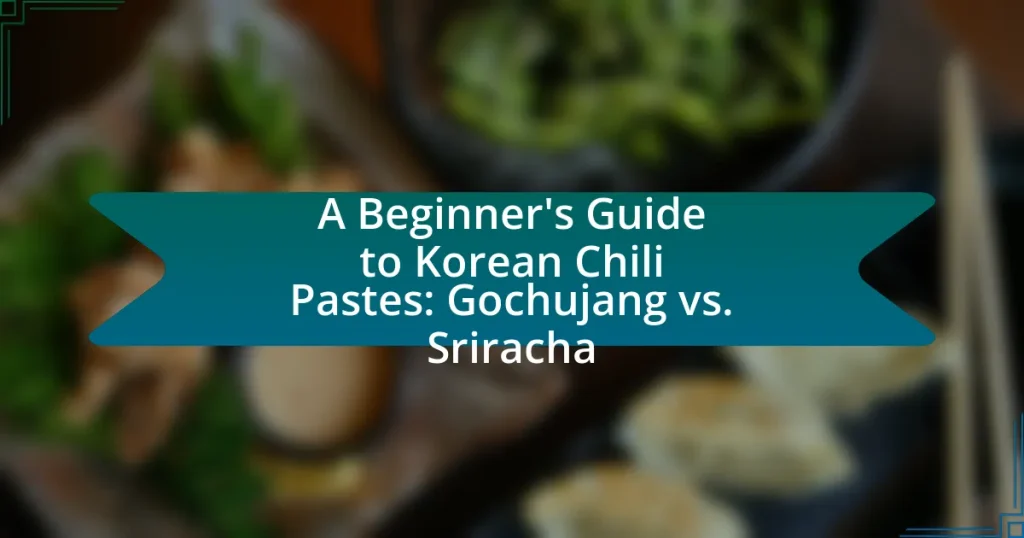Korean chili pastes, particularly Gochujang and Sriracha, are essential condiments in various cuisines, each with distinct flavor profiles and uses. Gochujang is a fermented paste made from Korean red chili powder, glutinous rice, fermented soybeans, and salt, known for its sweet, spicy, and umami flavors. In contrast, Sriracha is a hot sauce originating from Thailand, combining chili peppers, vinegar, garlic, sugar, and salt, offering a tangy and garlicky heat. This guide explores the ingredients, traditional preparation methods, flavor profiles, culinary applications, and storage tips for both Gochujang and Sriracha, providing beginners with essential knowledge for incorporating these chili pastes into their cooking.

What are Korean Chili Pastes?
Korean chili pastes are fermented condiments primarily made from Korean red chili powder, glutinous rice, fermented soybeans, and salt. Gochujang is the most well-known type of Korean chili paste, characterized by its sweet, spicy, and umami flavors, which result from the fermentation process that can take several months. This paste is a staple in Korean cuisine, used in various dishes such as stews, marinades, and sauces, contributing both heat and depth of flavor. The fermentation not only enhances the taste but also adds nutritional benefits, including probiotics.
What is Gochujang?
Gochujang is a traditional Korean chili paste made from fermented soybeans, red chili powder, glutinous rice, and salt. This unique condiment has a rich, savory, and slightly sweet flavor profile, which is achieved through the fermentation process that enhances its complexity. Gochujang is a staple in Korean cuisine, often used in dishes such as bibimbap and tteokbokki, and it contributes to the umami taste that characterizes many Korean recipes. Its historical significance dates back to the 16th century, when it became a fundamental ingredient in Korean cooking, reflecting the country’s culinary evolution.
What are the main ingredients of Gochujang?
The main ingredients of Gochujang are fermented soybeans, glutinous rice, red chili powder, and salt. Fermented soybeans provide the base for the paste, while glutinous rice contributes to its texture and sweetness. Red chili powder gives Gochujang its characteristic heat and color, and salt acts as a preservative and flavor enhancer. These ingredients combine to create a complex flavor profile that is both spicy and savory, making Gochujang a staple in Korean cuisine.
How is Gochujang traditionally made?
Gochujang is traditionally made by fermenting a mixture of glutinous rice, powdered fermented soybeans, red chili powder, and salt. The process begins with cooking glutinous rice, which is then cooled and mixed with the powdered fermented soybeans, known as meju. This mixture is combined with red chili powder and salt, forming a thick paste. The paste is placed in an earthenware pot and left to ferment for several months, allowing the flavors to develop and deepen. This fermentation process is crucial, as it not only enhances the taste but also contributes to the paste’s unique umami flavor and rich color.
What is Sriracha?
Sriracha is a type of hot sauce made from chili peppers, vinegar, garlic, sugar, and salt. Originating from Thailand, Sriracha gained popularity in the United States in the late 20th century, particularly due to the Huy Fong Foods brand, which was founded by David Tran in 1980. The sauce is known for its distinctive balance of heat and sweetness, making it a versatile condiment used in various dishes, from Asian cuisine to American favorites.
What are the key ingredients in Sriracha?
The key ingredients in Sriracha are chili peppers, vinegar, garlic, sugar, and salt. These components combine to create the distinctive spicy, tangy, and slightly sweet flavor profile that Sriracha is known for. The chili peppers provide heat, while vinegar adds acidity, garlic contributes depth, sugar balances the spice, and salt enhances overall flavor.
How does Sriracha differ from other chili sauces?
Sriracha differs from other chili sauces primarily in its unique blend of ingredients and flavor profile. Unlike many chili sauces that focus solely on heat, Sriracha combines chili peppers, vinegar, garlic, sugar, and salt, resulting in a balance of spiciness, tanginess, and sweetness. This distinct combination creates a versatile sauce that enhances a variety of dishes, setting it apart from more straightforward hot sauces that may lack complexity. Additionally, Sriracha’s origin in Thai cuisine, particularly its association with the town of Si Racha, adds cultural significance that differentiates it from other chili sauces globally.

How do Gochujang and Sriracha compare?
Gochujang and Sriracha differ primarily in their ingredients and flavor profiles. Gochujang is a Korean chili paste made from fermented soybeans, red chili powder, glutinous rice, and salt, resulting in a thick, sweet, and savory flavor with a complex umami profile. In contrast, Sriracha is a Thai hot sauce primarily made from chili peppers, vinegar, garlic, sugar, and salt, offering a more straightforward spicy and tangy taste. The fermentation process in Gochujang contributes to its depth of flavor, while Sriracha’s vinegar base provides a sharpness that enhances its heat.
What are the flavor profiles of Gochujang and Sriracha?
Gochujang has a complex flavor profile characterized by its deep umami, sweetness, and mild heat, stemming from fermented red chili powder, glutinous rice, and soybeans. In contrast, Sriracha features a more straightforward flavor profile that combines sweetness, tanginess, and a sharper heat, primarily derived from red jalapeño peppers, vinegar, garlic, and sugar. The fermentation process of Gochujang contributes to its rich depth, while Sriracha’s ingredients create a fresher, more vibrant taste.
How does the sweetness of Gochujang affect its taste?
The sweetness of Gochujang significantly enhances its overall taste profile by balancing the heat from the chili peppers and adding depth to its flavor. This sweetness, derived from ingredients like glutinous rice and fermented soybeans, contributes to a complex umami flavor that is both savory and slightly sweet. The combination of sweetness and spiciness makes Gochujang versatile in various dishes, allowing it to complement ingredients in marinades, stews, and sauces effectively.
What role does vinegar play in Sriracha’s flavor?
Vinegar is a crucial component in Sriracha’s flavor profile, providing acidity that balances the heat of the chili peppers. This acidity enhances the overall taste by adding brightness and tanginess, which complements the sweetness from sugar and the savory notes from garlic. The specific type of vinegar used, often distilled or rice vinegar, contributes to the sauce’s distinctive sharpness, making it more versatile for various culinary applications.
What are the uses of Gochujang and Sriracha in cooking?
Gochujang and Sriracha are both used to add heat and flavor to various dishes. Gochujang, a Korean chili paste, is commonly used in marinades, stews, and as a base for sauces, providing a deep, fermented flavor along with sweetness. Sriracha, a Thai hot sauce, is often used as a condiment for dishes like noodles, tacos, and sandwiches, offering a tangy and garlicky heat. Both sauces enhance the overall taste profile of meals, making them popular in diverse cuisines.
How can Gochujang be incorporated into traditional dishes?
Gochujang can be incorporated into traditional dishes by using it as a base for marinades, sauces, and soups. For instance, it is commonly mixed with ingredients like soy sauce, sesame oil, and garlic to create a marinade for meats such as bulgogi. Additionally, gochujang is a key ingredient in dishes like bibimbap, where it adds depth and spice to the mixed rice and vegetables. Its fermented flavor enhances stews like kimchi jjigae, providing a rich umami profile. The versatility of gochujang allows it to be adapted into various recipes, making it a staple in Korean cuisine.
What are some popular recipes that use Sriracha?
Popular recipes that use Sriracha include Sriracha chicken wings, Sriracha shrimp tacos, and Sriracha ramen. These dishes highlight Sriracha’s versatility as a spicy condiment. For instance, Sriracha chicken wings are often coated in a mixture of Sriracha, butter, and garlic, creating a flavorful glaze that enhances the wings’ taste. Similarly, Sriracha shrimp tacos combine the heat of Sriracha with fresh ingredients like avocado and lime, resulting in a balanced and spicy meal. In ramen, Sriracha adds depth and heat to the broth, making it a popular choice for those seeking a spicy kick in their noodles.

What should beginners know about using these chili pastes?
Beginners should know that using chili pastes like gochujang and sriracha requires understanding their flavor profiles and heat levels. Gochujang is a fermented Korean chili paste that offers a sweet, savory, and spicy flavor, while sriracha is a hot sauce with a tangy and garlicky taste. Beginners should start with small amounts to gauge the heat and adjust according to personal preference, as gochujang typically has a milder heat compared to sriracha. Additionally, both pastes can be used in various dishes, such as marinades, soups, and stir-fries, enhancing the overall flavor. Understanding these characteristics will help beginners effectively incorporate these chili pastes into their cooking.
How can beginners choose between Gochujang and Sriracha?
Beginners can choose between Gochujang and Sriracha by considering their flavor profiles and intended culinary uses. Gochujang is a fermented Korean chili paste that offers a rich, sweet, and umami flavor, making it ideal for stews, marinades, and dishes that require depth. In contrast, Sriracha is a hot sauce with a tangy, garlicky flavor, suitable for drizzling on foods or adding heat to sauces. The choice ultimately depends on whether one prefers the complex sweetness of Gochujang or the straightforward heat of Sriracha.
What factors should influence the choice of chili paste?
The choice of chili paste should be influenced by flavor profile, heat level, and intended use in dishes. Flavor profile is crucial as different chili pastes, such as gochujang and sriracha, offer distinct tastes; gochujang is fermented and sweet, while sriracha is tangy and garlicky. Heat level varies significantly, with gochujang typically being milder compared to the spicier sriracha, making it essential to consider personal spice tolerance. Additionally, the intended use in recipes, such as marinades, sauces, or dips, can dictate which chili paste is more suitable, as each paste complements different culinary applications.
How can one experiment with both pastes in cooking?
To experiment with both gochujang and sriracha in cooking, one can start by substituting one paste for the other in various recipes to understand their flavor profiles. Gochujang, a fermented Korean chili paste, offers a sweet and savory taste, while sriracha, a Thai hot sauce, provides a tangy and spicy kick. By mixing the two pastes in sauces, marinades, or dressings, cooks can create unique flavor combinations that enhance dishes. For instance, combining equal parts of gochujang and sriracha in a stir-fry sauce can balance sweetness and heat, allowing for a versatile condiment. This method of substitution and combination allows for a practical exploration of how each paste influences the overall taste and texture of the dish.
What are some tips for storing and using Gochujang and Sriracha?
To store Gochujang and Sriracha effectively, keep both sauces in a cool, dark place, ideally in the refrigerator after opening to maintain their flavor and freshness. Gochujang, a fermented chili paste, can last for several months in the fridge due to its high salt content, while Sriracha, which contains vinegar, can also be stored in the refrigerator for optimal shelf life. When using Gochujang, mix it with other ingredients to balance its intense flavor, and for Sriracha, use it as a condiment or ingredient in sauces and marinades to enhance dishes. These storage methods and usage tips ensure both sauces retain their quality and provide the best flavor in culinary applications.
How should Gochujang be stored for optimal freshness?
Gochujang should be stored in an airtight container in a cool, dark place, such as a pantry or refrigerator, to maintain its optimal freshness. This storage method prevents exposure to light and air, which can degrade the quality and flavor of the chili paste over time. Refrigeration is particularly effective in extending the shelf life of Gochujang, as it slows down the fermentation process and preserves its unique taste and texture.
What are the best practices for using Sriracha in various dishes?
The best practices for using Sriracha in various dishes include using it as a condiment, incorporating it into sauces, and adding it to marinades. As a condiment, Sriracha enhances the flavor of dishes like eggs, burgers, and tacos, providing a spicy kick. When incorporated into sauces, it can elevate the taste of dressings, dips, and glazes, blending well with ingredients like mayonnaise or soy sauce. Additionally, adding Sriracha to marinades for meats or vegetables infuses them with heat and depth of flavor, making it a versatile ingredient in cooking. These practices leverage Sriracha’s unique balance of heat and sweetness, making it a popular choice in diverse culinary applications.


